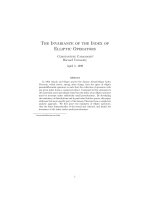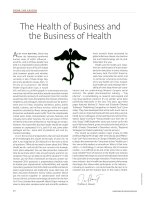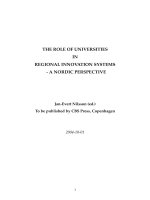Tài liệu The Role of Public Regional Universities in Community and Economic Development doc
Bạn đang xem bản rút gọn của tài liệu. Xem và tải ngay bản đầy đủ của tài liệu tại đây (941.51 KB, 29 trang )
The Role of Public Regional
Universities in Community and
Economic Development
December 6, 2005
Higher Education and Economic
Development in Pennsylvania
The Commonwealth is facing significant economic
development challenges
Per-capita income growth in Pennsylvania is below the
U.S. average, continuing a trend from the last decade
Devoting resources to higher education can accelerate
economic development and income growth
Areas in need of economic stimulus or that are growing
economically demand greater higher educational services
Presentation Outline
Public Purpose of Higher Education
The Role of Public Higher Education
Dimensions of Social and Economic Value
Higher Education’s Contribution to
Economic Development
PASSHE Economic Development
Best Practice Highlights
Questions
Public Purpose of Higher Education
Focus on Students
(Maximizing Human Capital)
Post-secondary education provides students the opportunity
to increase their individual, social and economic value
Increased lifetime real income
Improved quality of life
Focus on Society
(Maximizing Social Welfare)
Increased productivity, real wealth, civic responsibility and
participation
The Role of Public Higher Education
From the student’s perspective:
Public and private higher education have the similar objective
of providing high quality educational opportunities
The distinguishing characteristics of public higher education
are its degree of access and affordability
From society’s perspective:
Public higher education addresses a wide range of social and
economic needs in addition to its primary purpose of ensuring
access to a high quality, affordable education
Dimensions of Social and
Economic Value
Generally, public universities:
Provide access to educational opportunities of quality
and substance
Stimulate intellectual growth and individual productive
capacity
Ensure a stable supply of knowledge and skills in high
need areas
Increase the size, diversity of skills and productivity of the
labor force
Dimensions of Social and
Economic Value
Regional public institutions also:
Enhance the quality of life in communities (stewards of
place)
Represent long-term public investments that help ensure
regional stability (economic anchors)
Retain graduates and jobs within their respective service
regions
Attract private investment (wealth and/or job creation)
Stabilize regional economies, stimulate economic growth
and preserve the value of regional economic/social assets
Higher Education’s Contribution to
Economic Development
Direct Impact: Mission-Based Contributions
Education and Human Capital Development
Creators of Knowledge and Sources of Innovation
Indirect Impact: Operations
Purchasing and Procurement Activities
Preservation of Economic Infrastructure
Stable and Larger Tax Base
Indirect Impact: Outreach
Business Incubators
Entrepreneurial Assistance
Collaboration with Business and Government
Direct Contributions to
Economic Development
Mission-Based Contributions
Mission-Based Contributions
Universities create economic value through education and
training
Salary Differentials
Compared with workers who have only a high school diploma,
those with post-secondary degrees are twice as likely to have a job
and, on average, command a significantly higher salary ($42,000
annually vs. $28,000 in average annual salary)
Preserving Value
Continuing education is important to preserving the market value
of specialized education – particularly in professional fields
Continuing education and workforce development opportunities
provide support for entrepreneurial activity – promoting the
creation and retention of jobs
Percent Population 25+ with Bachelor’s Degrees or Higher
Source: U.S. Census Bureau
Mission-Based Contributions
State Percent Rank
Massachusetts 33.2 1
Maryland
31.4 4
New Jersey
29.8 5
New York
27.4 11
Delaware
25.0 19
Pennsylvania
22.4 29
Ohio
21.1 39
West Virginia
14.8 50
United States
24.4
Bachelor's Degree Attainment or Higher,
2000
Pennsylvania ranks 29
th
in degree attainment
Mission-Based Contributions
Universities are creators of knowledge and are sources of
innovation that can provide the impetus for economic development
Applying knowledge and forming intellectual capital
Nearly two-thirds of National Association of State Universities and
Land-Grant Colleges (NASULGC) have research parks or business
incubators (PASSHE has 5 university-based incubators)
Commercializing intellectual property
Over the past five years, NASULGC universities reported an
average of 11 start-up companies created (per university) as a result
of generated intellectual property
Scholarship, cultural and intellectual value
Regional public universities are a significant source of cultural
events programming, artistic and creative presentations
(Source: Stepping Forward as Stewards of Place, AASCU – May 2002)
Indirect Contributions to
Economic Development
Impact of University Operations
Impact of University Operations
Investments in higher education help create sustainable
economic development leading to higher economic growth
Purchasing and Procurement Activities
Annual budgetary expenditures (PASSHE: $1.2 billion operating
budget and more than 12,000 staff and faculty)
Many students work on campus and within the community
University, faculty, staff, student and visitor spending adds to the
local economy
Universities provide a major stimulus to their state and regional
economies, including generating an average return of up to $5 for
every $1 of state tax dollar invested
(Source: National Association of State Universities and Land-Grant Colleges - August 2001)
Impact of University Operations
Preservation of local economic infrastructure
Universities serve as an economic anchor within the regional
community – by their existence, ensuring a greater retention of
graduates and jobs within their service regions
For every job on a public university campus, another 1.6 jobs are
generated beyond the campus
(Source: National Association of State Universities and Land-Grant Colleges - August 2001)
Expanding and stabilizing regional and state-wide tax base
Rural & Urban Counties Served by
PASSHE Universities
According to the Center for Rural Pennsylvania, a county is considered rural when its population density is below the statewide
density of 274 persons per square mile. Urban counties had a population density of 274+, Calendar Year 2000
ERIE
Porreco
Edinboro
CRAWFORD
WARRENN
Northern
Tier
MCKEAN
Northern
Tier
(SL/CL)
POTTER
Couders-
port
TIOGA
Mansfield
BRADFORD
Sayre
SUSQUEHANNA
Northern Tier
MONROE
East
Stroudsburg
VENANGO
CLARION
BUTLER(CA)
Slippery Rock
Cranberry(SL)
ARMSTRONG
Allegheny
(CL)
CCAC (IN)
WESTMORELAND
Monroeville
WASHINGTON
Southpointe
California
JEFFER-
SON
Punxsu-
tawney
CLEARFIELD
INDIANA
Johns-
town (IN)
Cambria
(CA)
SOMERSET
BEDFORD
CUMBERLAND
Shippensburg
Carlisle
CLINTON
Lock
Haven
Northumber-
land
Columbia
Bloomsburg
DAUPHIN
Dixon
Univ
Center
LANCASTER
Millersville
Lancaster
BERKS
Kutztown
Reading
LEHIGH
Allentown
CHESTER
West
Chester
DELAWARE
Cheyney
PHIL CH/KU
County Locations of State System Universities,
Branch Campuses and Other Teaching Sites
PASSHE in 33 of 67 Counties
Understanding Regional Economic Impact
Indirect Contributions to
Economic Development
University Outreach
University Outreach
Incubators and other support for small business
development
Workforce incentive for firms to locate in region
Entrepreneurship as a career option and a skill set
Universities provide entrepreneurial education and
assistance
Can be taught through higher educational institutions
Collaboration with business and government
Economic Development Programs
and Initiatives
Business accelerators and/or entrepreneurial initiatives
Linking teaching and research to business opportunities
Collaboration with local business and industry
Small Business Development Centers
Collaboration with government
Partnerships with government agencies to provide services,
training or other funding
Keystone Innovation Zone partnerships at five PASSHE
universities
Economic Development Programs
and Initiatives
Collaboration with Community and Non-Profit Groups
Partnerships linked to community and non-profits
Corporate Alliances
Specific and direct sponsorships or partnerships with area
businesses
Collaboration with Other Educational Institutions
Partnerships with local and regional educational providers
Workforce Development and Training
Programs that train students/employees for the workforce
(for example, all PASSHE universities are involved in WEDnetPA)
PASSHE Economic Development
Best Practice Highlights
Best Practice Highlights
Bloomsburg University
Master’s of Science in Radiologist Assistance - workforce
development and training; providing a career path option for
radiologic technologists
California University
Government Agency Coordination Office – regional economic
development; assisting businesses in their provision of services to
government
Cheyney University
Disadvantaged Business Enterprise – collaborating with business,
industry and government agencies; providing assistance to
disadvantaged businesses in securing PennDOT contracts
Best Practice Highlights
Clarion University
Support for Entrepreneurial and Existing Businesses – business
accelerator/entrepreneurial initiatives; helping new businesses
through critical start-up and growth stages
East Stroudsburg University
Center for Research and Economic Development Business
Accelerator – collaborating with business and industry and
business accelerator/entrepreneurial activities; building a more
diversified business base
Edinboro University
James F. Drane Bioethics Institute – workforce development,
training and collaboration with education; supporting collaborative
research on bioethics









